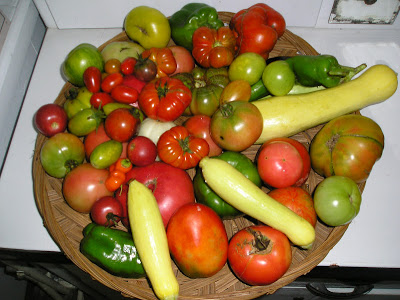 |
| Flowering Rosemary Indoors at Barb P's house |
 |
| Another photo from Barb |
 |
| Rosemary in a container outdoors in summer. (C. Kagan) |
OUTDOORS TO INDOORS
Because rosemary does not overwinter well in our area, it is advisable to treat it as a container plant which makes it infinitely easier to bring indoors. However, if you have rosemary planted out, you may pot it up using appropriate potting soil (not garden soil) and pot size with a drainage hole and tray. Follow recommendations about preparing your plants to bring them inside.If possible, acclimate the plant to the indoors by bringing it inside a few weeks before the first expected frost date, October 15 here in S. Central PA. If you can open the windows and keep the indoor temperatures lows, it will make the transition easier than suddenly bringing it into a warm house.
INDOORS
All I want is for my rosemary to make it through the winter in living condition, so I can drag it back outside when the weather gets warm next year.Fertilizer and Pruning: I don't encourage my rosemary to grow during the winter so I don't fertilizer or prune, except for a snip here and there. Rosemary will go dormant during the winter.
Light: Rosemary needs 6-8 hours of light as it did outside. A good south facing window may well do but you may have to supplement it with artificial light. A fluorescent light or grow light can help. Rotate the plant every week or so to keep the plant growing evenly on all sides.
Temperature: As a native Mediterranean, mild-region plant, rosemary will expect cool winters (not freezing) temperatures. An area that is consistently 55 to 60°F is good.
Watering: As with most plants brought in to overwinter, consistent watering is one of the important keys to keeping it alive. Water when the surface is dry, usually once every 2 weeks until the soil is wet and water comes through the drainage hole.
After about an hour, empty the water from the saucer so the roots are not sitting in water. Rosemary will benefit from misting. A tip for watering all indoor plants is to allow tap water to sit in an open container overnight to allow the chlorine to dissipate.
Air Circulation: Good air circulation can alleviate some problems with mildew and mold. If you have several plants overwintering indoors, make sure there is good spacing between them.
ABOUT ROSEMARY
Rosemary is the herb of remembrance. Although today we typically think of it as remembering loved ones that have passed, the Greeks thought it increased memory. Greek scholars were said to wear wreaths of rosemary around their heads when taking exams to help them remember their lessons.The name rosemary derives from the Latin for dew-"ros"- and sea -"marinus;" thus, dew of the sea. A legend says that the Virgin Mary spread her blue cloak over a white-blossomed rosemary bush when she was resting causing the flowers to turn blue. The shrub then became know as the "Rose of Mary."
Other Links of Interest:
University of Illinois Extension: Rosemary
Overwintering Rosemary





















